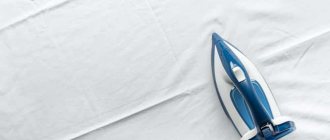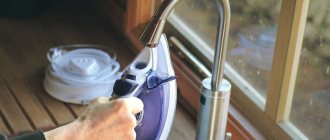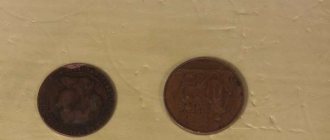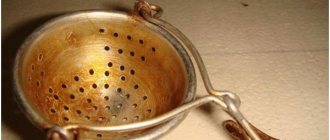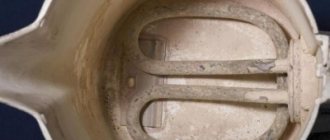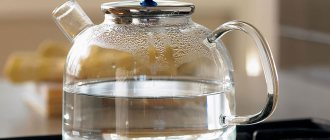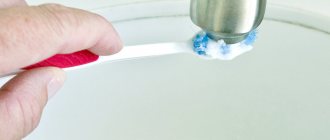A thermos is a very convenient thing for always having warm coffee or tea on hand. But if the vessel is made of stainless steel, then it absorbs various odors very strongly. And besides, tea or coffee deposits form on it. And, of course, in this case it is simply impossible to store any drinks in it. Scale, plaque and unpleasant odor from thermal containers will certainly negatively affect the taste of the drink. But this will not become a difficulty if you know how to clean the inside of a stainless steel thermos from tea deposits.
Types of pollution
Over time, a persistent coating from your favorite drink or even mold appears on your brand new thermos. This is not pleasing to the eye and is harmful to health. Why is this happening?
Tea and coffee stains
A cup of hot drink pleasantly warms you up in the cold. But with constant use of the thermos, an unpleasant brown film appears inside. It is formed due to caffeine and essential oils.
Scale
Hard water and insufficient care lead to limescale deposits inside the thermos. It may contain deposits of chlorine, heavy metals, bacteria, so it is better to clean it.
Mold (fungus)
Sometimes when dishes are stored closed for a long time, mold develops. Fungus appears especially often when a thermos is still damp.
Mold has an unpleasant appearance and smell and spoils the taste of drinks and food. It can cause an allergic reaction and poisoning, so you need to get rid of it.
Cleaning methods
There are quite a lot of them. There are special preparations that can be used to clean a thermos. But you can also use improvised means that are convenient for washing thermal dishes at home.
Baking soda
It will easily clean the flask from scale and deposits, and at the same time disinfect it. A proven, inexpensive product that even copes with mold.
Add soda to hot water. Pour 1 tsp, 3 tbsp. l. or even more: it all depends on the degree of pollution. We stand for 6–8 hours. Then rinse the thermos.
Salt
Removes plaque, stains, plus removes odor. You will need 8 tbsp. l. salt per 1 liter of hot water. Some people make a more concentrated saline solution. The saline solution is left for 6–8 hours, after which the product is washed.
Mustard powder
The recipe is simple: 2–5 tbsp. l. The powder is mixed in a bowl with hot water, closed, shaken and left for 4-8 hours, washed.
Lemon, citric acid
Effectively clean the flask from brewing and coffee deposits. Citrus is cut into slices, placed in a bowl and poured with boiling water. Wait a few hours and wash the thermos.
Instead of lemon, you can take 2 tsp. citric acid. In case of heavy contamination, add 2 tbsp. l substances. After 3–8 hours, wash the dishes.
Vinegar
An aqueous solution with food vinegar helps to clean the flask from tea and scale. Take one third of vinegar and two thirds of hot water and pour it into the flask. After 2–6 hours, thoroughly wash the product with dishwashing gel.
If you add a little baking soda to the vinegar, everything will clean up very quickly.
Baking powder or baking powder
They usually contain soda and citric acid, which help remove scale and wash plaque from the inside of the thermos. You need to take 2-3 tbsp. l. or 1-2 sachets of the substance and mix with warm water in a thermal container, leave for 2-3 hours, then rinse the product.
Rice or pearl barley
They have cleansing properties. It is enough to pour a few tablespoons of rice or pearl barley into a flask and pour boiling water over it. Then close, shake and leave for a couple of hours. It is advisable to shake the thermos 3-4 times per hour. All that remains is to rinse the dishes.
The recipe works even better with the addition of 1-2 tsp. soda
Soda
Successfully fights stains from coffee and tea. They use Pepsi, Fanta, Sprite. Coca-Cola is especially praised.
However, glassware manufacturers do not recommend storing soda in a thermos: due to the large amount of carbon dioxide, the surface of the flask may deteriorate. Therefore, it is not advisable to hold a carbonated drink for longer than 20 minutes.
Do not close the lid so that the stopper does not fly out or the glass flask is damaged.
Another recipe: boil the soda so that the gas comes out, and then pour it into the bowl. Leave for several hours, then wash.
Ammonia solution
Long-term exposure of a steel flask to ammonia will damage it. Plus, the ammonia solution will corrode rubber gaskets and leave an unpleasant odor.
But you can occasionally wipe the flask with ammonia, or use an aqueous solution. To prepare the solution, add 5–10 drops of the substance to each liter of liquid, stir and leave in the flask for a short time. After cleaning, wash the dishes thoroughly.
Medical alcohol
Fill the flask one-third full with alcohol. Add warm water. Close and shake well. Leave for 45–60 minutes. Afterwards we rinse.
The recipe can be used no more than 3-4 times a year so as not to spoil the flask.
Dish gel, laundry soap
A simple but effective solution. The products remove greasy stains well and fight mold and plaque.
Dishwasher detergent
Special tablets and gel are potent agents. They will cope with black stains from drinks and fungus. After cleaning the dishes, wash them with dish gel and pour boiling water over them several times.
Before use, read the instructions and make sure that the selected product is suitable for your dishes.
Tooth powder or paste
Suitable for cleaning stainless steel flasks. Wipe it with a soft sponge or cloth. Afterwards, rinse with water.
Tablet "Korega"
Denture cleaning tablets are great for cleaning the inside of a thermos. They remove even stubborn stains from drinks or lime.
Use warm water: it should not be too hot. You will need 1-2 tablets, and more if it is heavily soiled. Let the solution sit in the container for 6–8 hours, then rinse.
Do not pour water to the very top of the flask so that the resulting foam does not run out over the edge. Or carry out the procedure in the sink.
Hydrogen peroxide with soda
Take 100 g of soda and use peroxide to make a paste. Gently wipe the flask with it, leave it to stand for a while and rinse off.
Special anti-scale and plaque products
To clean stainless steel utensils, specially designed products are used:
- "Silit";
- "Antiscale";
- "The Shine of Steel";
- "Dafor."
They clean the flask well from plaque and mold. Any drug of your choice is poured with boiling water and left in a thermos for an average of 1 hour. Then they wash the dishes.
Causes of plaque
Before you figure out how to clean a thermos from tea deposits, you need to find out why it appears there.
Layering of tea on the walls occurs due to the presence of phenols, tannins and the alkaloid thein. It is because of them that the drink acquires an astringent taste. When the temperature of the tea drops, these substances can no longer be in solution and are separated. Therefore, an oily film appears on the drink, which shimmers in different colors. And, by the way, there are more of these substances in black tea.
And when the thermal cookware moves, for example, you tilt it, this film gets on the walls and dries to them very quickly.
It is not so easy to wash it. And if you can still try to wipe the lid in the usual way with a sponge, then you certainly won’t be able to clean the flask that way. Therefore, often all they do with it is rinse it a little under running water.
And the longer the plaque collects in the thermos, the thicker its layer will become. And it will become increasingly difficult to wash it off. Tea residue settles on the dishes after the first use. It has very bad effects on the human body. And the worst thing about it is the blood vessels and the liver.
Plaque also appears due to hard water, irregular and careless washing.
Now, knowing why plaque forms on the walls of dishes, let’s move on to how to clean a stainless steel thermos.
What not to use
To avoid damaging the thermos flask, do not use rough cleaning methods that will leave scratches or damage the inner surface. After all, damage renders thermal cookware unusable. Here's what you can't clean:
- iron scourers for dishes;
- hard brushes;
- abrasive detergents;
- sand;
- crushed eggshells;
- aggressive chemistry.
What will suit? A soft brush, sponge, cloth, delicate detergents - special and improvised.
General recommendations
Stainless steel thermoses are susceptible to the formation of tea deposits, which eat into the material, making it difficult to remove. It is especially difficult to clean the inside of the product, so it is worth using some tricks for washing it. In addition, to avoid severe contamination, do not forget about the basic recommendations for operating the device.
- Wash the thermos immediately after use using soapy water and a dish brush.
- For cleaning, do not choose abrasives or brushes with metal bristles.
- Do not use bleach powders to prevent damage to the rubber parts and seams of the thermos.
- After cleaning, dry the product to avoid the appearance of an unpleasant odor or fungus.
The nuances of washing different parts of a thermos
After each use, you must immediately wash the thermos. Moreover, you need to wash it correctly, that is, all its parts - the flask, the lid, the stopper. Then you must definitely dry all the parts, and only then put them away for storage: this will prevent the appearance of mold.
Flask
When caring for a thermos, you should take into account the characteristics of the material from which the flask is made. Then the dishes will last longer.
Metal, stainless steel
These flasks are durable and hold heat well. But they get scratched easily.
Metal flasks can withstand various types of cleaning, but not harsh abrasives. Here's what will do:
- lemon;
- lemon acid;
- baking soda;
- vinegar;
- baking powder for the dough;
- baking powder;
- rice;
- pearl barley;
- soda;
- "Coca-Cola" (with caution);
- tablets like "Korega".
Glass
Holds heat well, but is fragile. Therefore, when washing, the glass flask should be handled with particular care: in order not to break it, it must be cleaned without unnecessary mechanical effort.
When cleaning, use gentle products:
- lemon;
- lemon acid;
- vinegar (preferably apple);
- carbonated drinks;
- saline solution;
- mustard;
- dishwashing gel.
Teflon coated
Metal flasks with Teflon coating are similar in their characteristics to steel ones. They cannot be cleaned with abrasives or aggressive chemicals. Other washing methods will work.
Lid (regular and with button), plug
These parts of the thermos also require mandatory maintenance. After all, they also accumulate food particles that need to be cleaned.
The push-button cover is washed in the “open” position. Plus they don't close while drying.
After drying, there is no need to seal the lid of the thermos tightly: it is better to store the thermos open or with little air entering the flask. This will prevent mold from forming.
Narrow neck
A thermos with a narrow neck is not always easy to clean from black deposits inside. But there are ways. In fact, it can be cleaned even without a brush.
To begin with, you can fill the flask with hot water to the top and let it stand. Then you can apply the cleaning method described above with citric acid, soda, cereal, mustard. You will have to shake the thermos for a while to mechanically remove any stuck-on food particles or deposits.
Useful tips
Some useful recommendations for cleaning thermal cookware from plaque and scale:
- with frequent use, clean once every 2-3 months;
- after draining the remaining drink, add a drop of liquid soap, add water and shake vigorously, then rinse;
- When cleaning stains, first use simple home remedies - soap, soda, vinegar, resort to aggressive drugs only as a last resort.
It is important to thoroughly rinse the stopper and lid - using a brush or toothbrush to clean the gaps and irregularities where most dirt accumulates.
What not to use
In the desire to give the original cleanliness, many try to clean the thermos in ways that are dangerous to humans or hopelessly damage the thermal insulation. The following should not be used when washing flasks made of any material:
- egg shells or other sharp-edged abrasives;
- household chemicals not intended for dishes - for plumbing purposes, acids;
- hard brushes, metal mesh for dishes.
After such cleaning, you can get poisoned by drinks, which will also quickly cool down in a damaged thermal container.
Is it dishwasher safe?
The thermos is suitable only for delicate hand washing. Many people are interested in why it cannot be washed in the dishwasher. The answer is simple: the thermal cookware will go bad.
When washing in the dishwasher, the thermos sits in hot water for a long time. As a result, the heat-insulating material fails, so the dishes no longer retain heat. And if water gets between the body and the flask, a musty, damp smell appears.
The thermos should also not be used in microwave ovens. Plus leave it near fire and heating devices.
Getting rid of the smell
If you have cleaned the insides of the thermos from scale, but you are bothered by an unpleasant odor, use one of the following methods.
- Regular dry mustard, although, of course, paste will do. Take two tablespoons of powder, dilute it in boiling water - you can do this directly in a thermos. Close the lid tightly and shake the pan. Repeat the manipulations periodically for 12 hours. By the way, if you want to not only remove foreign odors, but also clean out coffee deposits using mustard, make a thick paste from the powder and hot water and spread it on the inside of the thermos walls. When the mixture dries, pour boiling water and leave the vessel for a day.
- It's amazing what regular table salt is capable of - I mean stone, coarsely ground, but not "Extra". With it you need to repeat all the same steps as with mustard powder or soda - just pour boiling water directly into the thermos. Don't forget to shake when you remember.
- Sometimes it is impossible to understand what the smell of new dishes is: musty or something chemical. In such cases, it is not easy to figure out how to eliminate the smell in a thermos. Rice may help. There are several ways to use it: 1. Simply place dry grains in a flask, loosely closing the lid, and store the vessel like that; 2. Place new wet grains inside for several days in a row until the smell goes away; 3. Brew rice with boiling water in a thermos, filling no more than half the volume. Keep for 10-12 hours, shaking occasionally.
The latter method, of course, will not remove coffee/tea deposits or scale, but it can eliminate the most persistent odor. In addition, rice is absolutely safe and can be used daily - unlike acid and chemical compounds.
How to treat a new thermos
After purchasing a new thermos, you should not immediately fill it with drink or food. Before first use, be sure to wash the product thoroughly. This way you will remove possible traces of factory technical lubricant, household contaminants and microbes from it so that they do not get into your food.
It's easy to do. It is enough to wash the thermos with warm water and dishwashing gel. Additionally, you can pour boiling water over the product. Then dry.
Every time before using a thermos, especially with a glass flask, it should be prepared: pour hot or cold water for 2-3 minutes to heat or cool the flask before use.
Prevention of plaque and mold formation
The best remedy against plaque is prevention. If you regularly properly care for your thermos, it will last a long time, and unpleasant plaque and mold will not darken your mood.
Here are 6 simple rules that will help avoid the formation of deposits from drinks, hard water and mold:
- Wash the thermos completely after use.
- Dry it well when disassembled.
- Store it open or with the lid loosely closed.
- Do not keep prepared drinks in thermal containers for more than 24 hours.
- Use soft water for food and drinks you plan to put in the thermos.
- Brew coffee and tea in separate containers, and only then pour them into a thermos: this will prevent the formation of complex deposits.
Now you know useful tricks for handling a thermos and more than 15 proven ways to clean it. Try it, choose the best!
Did you like the article? Tell your friends about it:
1 1
Preventive measures
The main reason that plaque forms on the inner surface of the thermos and fungus appears is that the liquid remains in it for too long and it is not washed in a timely manner.
To avoid the need to clean a metal or glass thermos from old stains, resort to special preventive measures:
- The flask must be cleaned every time after you drink the drink, using a brush or soap.
- After this, wipe the inside and outside parts and leave until completely dry.
- Keep open.
- For preparing any drinks, use only filtered water.
- Prepare the drink separately, and only when it is ready, pour it into a thermal container.
- Do not store the drink inside for longer than one day.
If you follow these tips, you will not only avoid the appearance of complex stains, but also extend the life of your dishes. And then you won’t have to buy a special cleaning product.
Of course, nothing will help against the appearance of tea stains on the walls. He will constantly appear. But when you just see even small traces of it, it is better to wash them right away than to try to remove complex stains later. Moreover, you can only remove stubborn stains using aggressive agents.


